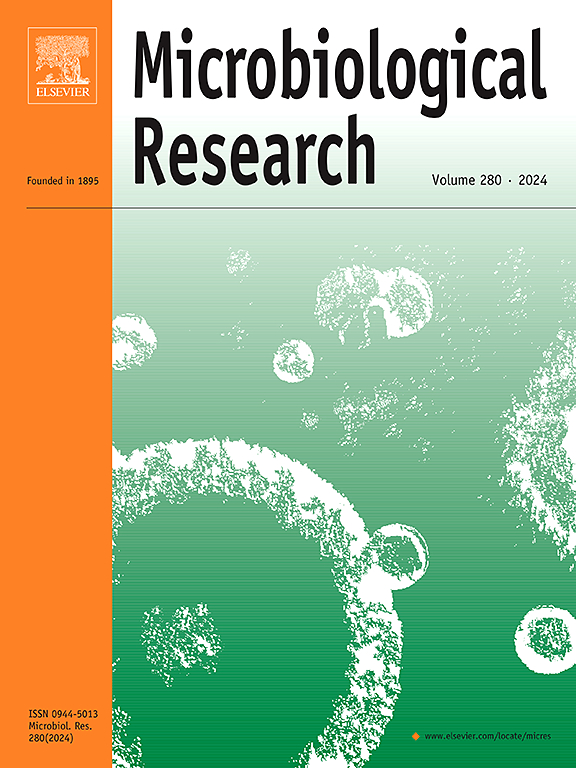Extracellular Hsp90 of Candida albicans contributes to the virulence of the pathogen by activating the NF-κB signaling pathway and inducing macrophage pyroptosis
IF 6.1
1区 生物学
Q1 MICROBIOLOGY
引用次数: 0
Abstract
Strategies aimed at targeting fungal extracellular heat shock protein 90 (eHsp90) using vaccines and antibodies have demonstrated encouraging potential in the prevention and management of invasive fungal diseases (IFDs). However, the precise underlying mechanism by which eHsp90 contributes to the heightened virulence of Candida albicans (C. albicans) remains an enigma, awaiting further elucidation. In our current research, we have found that the 47-kDa fragment of C. albicans Hsp90 (CaHsp90), which serves as the primary antigenic determinant, is not degraded within C. albicans cells. Moreover, we have discovered that extracellular CaHsp90 (eCaHsp90) is derived from the components of lysed C. albicans cells. We also generated recombinant CaHsp90 in Escherichia coli, and found that eCaHsp90 spreads beyond the initial C. albicans colonization site, thereby enhancing the overall virulence of the organism. Our results further clarify that eCaHsp90 activates the nuclear factor kappa-B (NF-κB) signaling pathway and upregulates the expression of NACHT, LRR, and PYD domains-containing protein 3 (NLRP3). This upregulation results in the activation of Gasdermin D (GSDMD) and subsequent macrophage pyroptosis, ultimately increasing the virulence of C. albicans. This study provides valuable insights into the mechanism by which eCaHsp90 contributes to the virulence of C. albicans, offering a pharmacological basis for antifungal strategies targeting fungal eHsp90.
白色念珠菌的胞外 Hsp90 通过激活 NF-κB 信号通路和诱导巨噬细胞热毒症,增强了病原体的毒力。
利用疫苗和抗体靶向真菌细胞外热休克蛋白 90(eHsp90)的策略在预防和治疗侵袭性真菌疾病(IFDs)方面已显示出令人鼓舞的潜力。然而,eHsp90 导致白念珠菌(C. albicans)毒力增强的确切内在机制仍是一个谜,有待进一步阐明。在目前的研究中,我们发现作为主要抗原决定因子的白念珠菌 Hsp90(CaHsp90)47-kDa 片段在白念珠菌细胞内不会降解。此外,我们还发现细胞外 CaHsp90(eCaHsp90)来自裂解的白僵菌细胞成分。我们还在大肠杆菌中生成了重组 CaHsp90,并发现 eCaHsp90 会扩散到白僵菌最初的定植点之外,从而增强了该生物的整体毒力。我们的研究结果进一步阐明,eCaHsp90 可激活核因子卡巴-B(NF-κB)信号通路,并上调含 NACHT、LRR 和 PYD 结构域的蛋白 3(NLRP3)的表达。这种上调会导致加斯德敏 D(GSDMD)的活化和随后的巨噬细胞脓毒症,最终增强白僵菌的毒力。这项研究为了解 eCaHsp90 促进白僵菌毒力的机制提供了宝贵的见解,为针对真菌 eHsp90 的抗真菌策略提供了药理学基础。
本文章由计算机程序翻译,如有差异,请以英文原文为准。
求助全文
约1分钟内获得全文
求助全文
来源期刊

Microbiological research
生物-微生物学
CiteScore
10.90
自引率
6.00%
发文量
249
审稿时长
29 days
期刊介绍:
Microbiological Research is devoted to publishing reports on prokaryotic and eukaryotic microorganisms such as yeasts, fungi, bacteria, archaea, and protozoa. Research on interactions between pathogenic microorganisms and their environment or hosts are also covered.
文献相关原料
公司名称
产品信息
阿拉丁
fluconazole
 求助内容:
求助内容: 应助结果提醒方式:
应助结果提醒方式:


